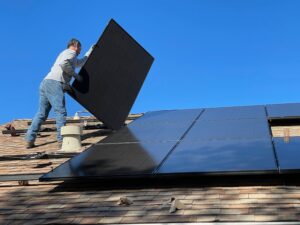How Does The Federal Solar Tax Credit Work? (2023 Guide)
The United States solar business has grown by over 10,000% since the federal government passed the Solar Investment Tax Credit (ITC) in 2006.
This credit, also known as the Residential Clean Energy Credit, is a federal tax credit that allows you to deduct up to 30% of the cost of your solar energy system.
It’s intended to encourage more homes to:
- install solar panels
- boost investment in the solar industry
- accelerate the pace of solar investment
In this article, we’ll look more closely at how the federal solar tax credit works and how it can help you save money on your solar panel system.
Key Takeaways
- The US solar industry has experienced significant growth since introducing the Solar Investment Tax Credit (ITC) in 2006.
- The ITC is a federal tax credit designed to encourage the installation of solar panels, boost investment in the solar industry, and accelerate solar investment.
- Homeowners can deduct up to 30% of the cost of their solar energy system from their federal income taxes.
- The current tax credit rate is 30% until 2032, after which it will gradually decrease before expiring at the end of 2035 unless extended by Congress.
- Stand-alone solar batteries with a minimum capacity of 3 kWh are also eligible for the 30% credit starting from January 1, 2023.
- To qualify for the federal solar tax credit, homeowners must own their solar installation, install the system during a qualifying tax year, and use the solar equipment at their primary or secondary residence.
- The ITC covers the total cost of the energy-efficient equipment, labor, additional supporting equipment, and applicable sales taxes.
- Additional solar incentives may include utility company incentives, state solar rebates, state solar tax credits, and solar renewable energy certificates (SRECs).
- If not fully utilized, the federal solar tax credit can be claimed in the current tax year or carried over to future tax years.
- To claim the solar tax credit, homeowners must complete IRS Form 5695 and include it with their federal income tax return, along with documentation of the system’s cost and installation date.
Background Of The Solar Tax Credit
During the Bush administration, the Energy Policy Act of 2005 was passed, which included the federal solar investment tax credit (ITC). The objective of establishing the ITC was to make it easier for people to switch to renewable energy.
It began as a 30% credit with a maximum limit of $2,000 as a residential solar tax credit (residential construction). Still, in 2008, that limit was eliminated.
Since 2008, the ITC has undergone a series of reductions and extensions. When signed into law in August 2022, the Inflation Reduction Act immediately increased the tax credit from its previous 26% to its current 30%, remaining until 2032.
In 2033, the federal ITC will be reduced to 26%, and in 2034, it will be reduced again, to 22%. The current expiration date is the end of 2035 unless Congress extends it again.
Beginning January 1, 2023, stand-alone solar batteries with a minimum capacity of 3 kilowatt-hours (kWh) are also eligible for the 30% credit. The battery doesn’t need to be connected directly to a solar panel system to be eligible.
How Does The Federal Solar Tax Credit Work?
As a homeowner, you can get a federal solar tax credit for the money you spend on installing solar panels. This will lower the amount you owe the government in federal income taxes (it doesn’t apply to state or taxes to local governments).
Using Tax Form 5695, you can only claim the Residential Clean Energy Credit once you install your solar system in the tax year.
The credit you get is then subtracted from your federal taxes, a dollar-for-dollar reduction. So, if you get $1,000 in credits, you’ll owe $1,000 less in taxes.
Once you figure out how many remaining credits you’ve gotten, you’ll need to add the information to get your renewable energy tax credit to a normal Form 1040 when you file your taxes.
Tax credits are not the same as tax refunds. You have to owe taxes to the government to get a tax credit, so the tax credit can cancel out some or all of the amount you owe.
Because the tax credit is based on the amount of tax you owe, if you don’t owe any (because you’re retired and don’t have any income), you won’t receive any money from it. Those tax dollars may be returned to you as a refund if they have already been withheld from your salary, but remember that you are only getting money back that you have already paid in taxes.
Last but not least, the solar panel federal tax credit can be subtracted from either regular federal tax liability or alternative minimum tax (AMT).
This means that the value of the tax credit can be claimed regardless of the method used to calculate your tax liability.
How To Qualify for the Federal Solar Tax Credit
The ITC is available to people who use solar energy anywhere in the United States. But there are specific requirements that must be met to get the tax credit.
Before you apply, make sure you meet these requirements.
New System Installed During a Qualifying Tax Year
You have to finish installing your solar panels within the qualifying time period. The 30% tax credit for homeowners is available until December 31, 2032. Otherwise, you’ll get 26% in 2023 and 22% in 2034.
The system must also be new or used for the first time in the tax year in question. You can’t get the tax credit if you buy a used solar system. For example, you can’t get the ITC if you bought a home with a solar energy system.
You Must Own Your Solar Installation
Solar power companies usually give you up to four ways to pay for your system:
- buy it outright
- get a loan
- rent it
- sign a power purchase agreement (PPA)
If a homeowner pays the full price or gets a loan, they own the solar project in its entirety. But if you decide to lease your system or sign a PPA, the solar company will still own the system.
You must own your solar system to qualify for the federal solar tax credit. If you want to take advantage of this incentive, choose either the up-front purchase or the solar loan.
The Property Is Your Primary or Secondary Residence
You must use the solar equipment at either your main or second homes. The tax break is for the following types of homes:
- Home
- Mobile home
- Condominium
- Manufactured home
- Shared apartments
- Houseboat
You can only get the ITC for rental properties if you live there for part of the year and rent it out when you’re not living there. But you can only claim the credit for as long as you live in the property.
For example, suppose you only live in the rental property for six months. In that case, you are only eligible for 50% of the deduction, (equivalent to six out of 12 months) versus a 100% deduction (equal to 12 out of 12 months).
What Does the Investment Tax Credit (ITC) for Solar Cover?
The ITC covers the energy-efficient equipment’s total cost, labor, and any other equipment that supports the system. The following equipment meets the requirements:
- Solar photovoltaic (PV) panels or PV cells
- Costs of labor to set up and install the solar PV system, such as fees for permits, developers, and inspections
- Devices that store solar energy and are charged by the PV system (stand-alone batteries qualify after Dec. 31, 2022)
- Extra parts that help the solar system work, like mounting gear, inverters, and wiring
- Sales taxes on qualified expenses (when applicable)
Only 25 states exempt solar panel purchases from sales tax, so this may not apply to you. Make sure to verify the solar policies in your state.
Other Solar Energy Incentives?
Besides the federal ITC, other solar incentives include:
- Utility company incentives: Local utilities incentivize homeowners who buy solar power systems. Depending on energy production, several firms support or rebate installation.
- State solar rebates: State governments may also provide financial incentives for solar panel installation. Typically, rebates assist cut the overall cost of installation by 10% to 20%.
- State solar tax credits: Some states offer tax credits for solar panel purchases. If so, you can claim the federal ITC and your state’s tax credit.
Subsidized loans, tax exemptions, and solar renewable energy certificates are other incentives (SRECs). Ask your local solar panel dealer about incentives before buying a system.
Don’t Miss Any Updates. Each week I’ll send you advice on how to reach financial independence with passive income from real estate.
Sign up for my newsletterFrequently Asked Questions (FAQs)
How does the solar tax credit work if I receive a tax refund?
If you get a tax refund, the solar panel tax credit will be added to it. If you owe money, it will be used to lower the amount you owe. You can use the credit in the current tax year or carry it over to the next year.
How many years can I claim the federal solar tax credit?
You can get the federal solar tax credit if you install and use a solar power system before December 31, 2023. After that, the credit will be worth less each year until it is phased out entirely.
Can I receive the solar tax credit if I don’t owe any taxes?
You might not be able to get the full solar tax credit if you don’t owe any taxes. You can still get the credit and carry any of it to future tax years if you don’t use it all.
Is the federal solar tax credit a one-time incentive?
The federal solar tax credit is not a one-time incentive. You can claim the credit for each year you have a system installed and put into service before the credit is phased out.
What documentation do I need to claim the solar tax credit?
You must complete IRS Form 5695 and include it with your federal income tax return to claim the solar tax credit. You’ll also need to show proof of the cost and when it was installed and put into use. Investors in residential solar energy can claim this tax credit under Section 25D. In contrast, those in commercial solar can do so under Section 48. Businesses that claim the credit do so on their business taxes, whereas individuals claim it on their income taxes.
Join the Passive Investors Circle




